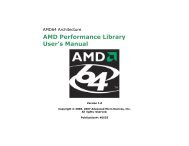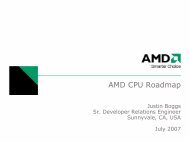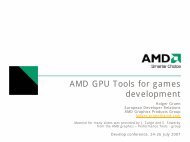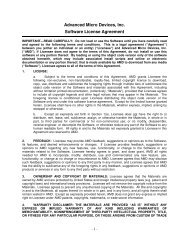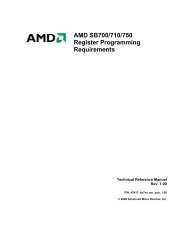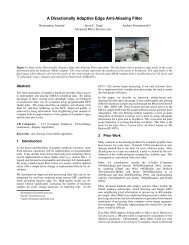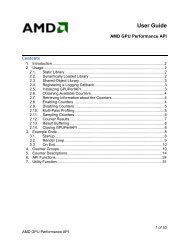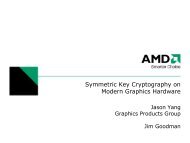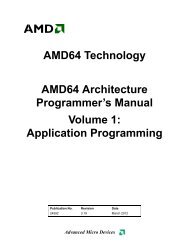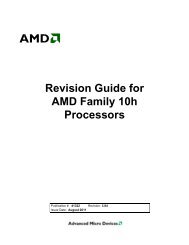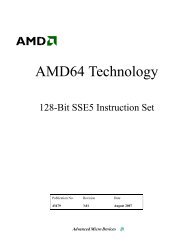Multi-Core Processor Technology - AMD Developer Central
Multi-Core Processor Technology - AMD Developer Central
Multi-Core Processor Technology - AMD Developer Central
Create successful ePaper yourself
Turn your PDF publications into a flip-book with our unique Google optimized e-Paper software.
<strong>Multi</strong>-<strong>Core</strong> <strong>Processor</strong> <strong>Technology</strong> –<br />
Maximizing CPU Performance in a<br />
Power-Constrained World<br />
Paul Teich<br />
Business Strategy<br />
CPG Server/Workstation<br />
paul.teich@amd.com<br />
<strong>AMD</strong>
The Issues<br />
Silicon designers can choose a variety of<br />
methods to increase processor performance<br />
Commercial end-customers are demanding:<br />
More capable systems with more capable processors<br />
That new systems stay within their existing<br />
power/thermal infrastructure<br />
<strong>Processor</strong> frequency and power consumption<br />
seem to be scaling in lockstep<br />
How can the industry-standard PC and Server<br />
industries stay on our historic performance curve<br />
without burning a hole in our motherboards?<br />
This session is not about process technology…
Session Outline<br />
Definition – What is a processor?<br />
<strong>Core</strong> Design<br />
System Architecture<br />
Manufacturing, Power, and Thermals<br />
<strong>Multi</strong>-<strong>Core</strong> <strong>Processor</strong> Architecture<br />
Performance Impacts
What is a <strong>Processor</strong>?<br />
A single chip package that fits in a socket<br />
≥1 cores (not much point in
A Representative <strong>Multi</strong>-<strong>Core</strong> <strong>Multi</strong> <strong>Core</strong> <strong>Processor</strong><br />
Dual-core <strong>AMD</strong><br />
Opteron processor<br />
is 199mm2 in 90nm<br />
Single-core <strong>AMD</strong><br />
Opteron processor is<br />
193mm2 in 130nm
<strong>Multi</strong>-<strong>Core</strong> <strong>Multi</strong> <strong>Core</strong> <strong>Processor</strong> Architecture
<strong>Core</strong> Design<br />
Frequency<br />
Is only as good as the rest of the core architecture<br />
<strong>AMD</strong> Opteron<br />
processor core<br />
architecture<br />
L1<br />
Icache<br />
64KB<br />
L1<br />
Dcache<br />
64KB<br />
44-entry<br />
Load/Store<br />
Queue<br />
Int Decode & Rename<br />
AGU<br />
ALU<br />
MULT<br />
Fetch<br />
Res Res Res<br />
AGU<br />
ALU<br />
AGU<br />
ALU<br />
Branch<br />
Prediction<br />
Scan/Align/Decode<br />
Fastpath Microcode Engine<br />
µops<br />
Instruction Control Unit (72 entries)<br />
FP Decode & Rename<br />
36-entry FP scheduler<br />
FADD FMUL FMISC
<strong>Core</strong> Design<br />
Functional units<br />
Superscalar is known territory<br />
Diminishing returns for adding more functional blocks<br />
Alternatives like VLIW have been considered and<br />
rejected by the market<br />
Single-threaded architectural performance is pegged<br />
Data paths<br />
Increasing bandwidth between functional units in a core<br />
makes a difference<br />
Such as comprehensive 64-bit design, but then where to?
<strong>Core</strong> Design<br />
Pipeline<br />
Deeper pipeline buys frequency at expense of<br />
increased cache miss penalty and lower instructions<br />
per clock<br />
Shallow pipeline gives better instructions per clock at<br />
the expense of frequency scaling<br />
Max frequency per core requires deeper pipelines<br />
Industry converging on middle ground…9 to 11 stages<br />
Successful RISC CPUs are in the same range<br />
Cache<br />
Cache size buys performance at expense of die size,<br />
it’s a direct hit to manufacturing cost<br />
Deep pipeline cache miss penalties are reduced by<br />
larger caches<br />
Not always the best match for shallow pipeline cores,<br />
as cache misses penalties are not as steep
Manufacturing<br />
Moore’s Law isn’t dead, more transistors for<br />
everyone!<br />
But…it doesn’t really mention scaling transistor power<br />
Chemistry and physics at nano-scale<br />
Stretching materials science<br />
Voltage doesn’t scale yet<br />
Transistor leakage current is increasing<br />
As manufacturing economies and frequency<br />
increase, power consumption is increasing<br />
disproportionately<br />
There are no process or architectural quick-fixes
Static Current vs. Frequency<br />
Non-linear as processors approach max frequency<br />
Static Current<br />
15<br />
0<br />
Embedded<br />
Parts<br />
Frequency<br />
Very High Leakage<br />
and Power<br />
Fast, Low<br />
Power<br />
1.0 1.5<br />
Fast, High<br />
Power
Power vs. Frequency<br />
In <strong>AMD</strong>’s process for 200MHz frequency steps, two<br />
steps back on frequency cuts power consumption by<br />
half…or lets you put twice the transistors on the die<br />
for the same power consumption as top frequency…<br />
Power Consumption<br />
2<br />
1.5<br />
1<br />
0.5<br />
n-4 n-3 n-2 n-1 n<br />
Frequency<br />
(Gross relative numbers summarized from a mountain of real data)
Thermal Density Decreases<br />
Hot spots<br />
Twice as many as in single-core<br />
Farther apart than in single-core<br />
With freq delta, cooler than in single-core<br />
Θ CA same for single-core at n and dual-core at n-2<br />
Larger die spreads heat more evenly in package<br />
Use identical heat sink, slightly better cooling with dual-core<br />
Works for this processor generation and next, Θ CA changes over major<br />
generations<br />
Thermal diode accuracy becomes an issue with dual-core…
<strong>Multi</strong>-<strong>Core</strong> <strong>Multi</strong> <strong>Core</strong> <strong>Processor</strong> Architecture<br />
Why integrate?<br />
Most functions are really small compared to the cores<br />
and cache<br />
All integrated logic runs at core frequency regardless of<br />
I/O speeds<br />
What to integrate?<br />
Northbridge crossbar switch is key to integrating<br />
anything else<br />
Memory controller to reduce memory latency and<br />
further reduce the need for cache<br />
High-speed serial links for system I/O<br />
What not to integrate?<br />
Most southbridge functions<br />
Graphics
<strong>AMD</strong> Opteron <strong>Processor</strong> Integrated Northbridge<br />
CPU 0<br />
Data<br />
CPU 1<br />
Data<br />
64-bit Data<br />
64-bit<br />
Command/Address<br />
CPU 0<br />
Probes<br />
16-bit<br />
Data/Command/Address<br />
CPU 1<br />
Probes<br />
CPU 0<br />
Requests<br />
CPU 1<br />
Requests<br />
System<br />
Request<br />
Interface<br />
(SRI)<br />
Crossbar<br />
(XBAR)<br />
HyperTransport<br />
HyperTransport Link 1 HyperTransport<br />
Link 0<br />
Link 2<br />
CPU 0<br />
Int<br />
CPU 1<br />
Int<br />
Advanced<br />
Priority<br />
Interrupt<br />
Controller<br />
(APIC)<br />
Memory<br />
Controller<br />
(MCT)<br />
DRAM<br />
Controller<br />
(DCT)<br />
RAS/CAS/Cntl<br />
DRAM<br />
Data
<strong>Multi</strong>-<strong>Core</strong>: <strong>Multi</strong> <strong>Core</strong>: Where <strong>Processor</strong> and System Collide<br />
Scales performance<br />
Dedicated resources for two simultaneous threads<br />
<strong>Multi</strong>ple cores will contend for memory and I/O<br />
bandwidth<br />
Northbridge is the bottleneck<br />
Integrating northbridge eliminates most of bottleneck<br />
<strong>Core</strong>s, cache and northbridge must be balanced for<br />
optimal performance<br />
More aggregate performance for:<br />
<strong>Multi</strong>-threaded apps<br />
Transactions – many instances of same app<br />
<strong>Multi</strong>-tasking<br />
Thread scheduling handled by OS<br />
BIOS notifies Windows of thread execution resources
Early Benchmark Estimates<br />
Decoder<br />
2P/2C – 2 proc. single-core<br />
4P/4C – 4 proc. single-core<br />
2P/4C – 2 proc. dual-core<br />
4P/8C – 4 proc. dual-core<br />
Frequencies<br />
Single-core = 2.4GHz<br />
Dual-core = 2.0GHz<br />
Identical system configs<br />
Memory, disks, network, etc.<br />
Early dual-core validation<br />
system used, different<br />
motherboards<br />
Platforms<br />
Platforms<br />
4P/8C<br />
4P/4C<br />
2P/4C<br />
2P/2C<br />
4P/8C<br />
4P/4C<br />
2P/4C<br />
2P/2C<br />
SPECint_rate2000 Peak Win SP1<br />
100<br />
163<br />
184<br />
% Comparison to Base 2P/2C<br />
OLTP Workload<br />
100<br />
148<br />
165<br />
% Comparison to Base 2P/2C<br />
244<br />
308<br />
SPEC and the benchmark name SPECint are registered<br />
trademarks of the Standard Performance Evaluation Corporation.<br />
SPEC scores for <strong>AMD</strong> Opteron Model 270 and 870 based<br />
systems are estimated.
Call To Action<br />
Most application software doesn’t need to do<br />
anything to benefit from dual-core<br />
Be aware that, for a processor within a given<br />
power envelope:<br />
Fewer cores will clock faster than more cores<br />
Single-threaded performance-sensitive applications<br />
More cores will out-perform fewer cores for<br />
<strong>Multi</strong>-threaded applications<br />
<strong>Multi</strong>-tasking response times<br />
Transaction processing<br />
<strong>Processor</strong> architecture impacts multi-core<br />
performance<br />
Process technology is only the ante<br />
Integration enables a balanced high-performance<br />
architecture
Additional Resources<br />
WinHEC Presentations:<br />
x86 Everywhere, Chris Herring, <strong>AMD</strong><br />
Web Resources:<br />
<strong>AMD</strong> http://www.amd.com/<br />
<strong>AMD</strong> <strong>Multi</strong>-<strong>Core</strong>: http://www.amd.com/multicore<br />
<strong>AMD</strong> Opteron <strong>Processor</strong> Tech Docs:<br />
http://www.amd.com/usen/<strong>Processor</strong>s/TechnicalResources/0,,30_182_739_9003,<br />
00.html<br />
<strong>AMD</strong> <strong>Multi</strong>-<strong>Core</strong> White Paper: http://www.amd.com/usen/assets/content_type/DownloadableAssets/MC_Whitep<br />
aper_vFINAL.pdf<br />
HyperTransport Consortium:<br />
http://www.hypertransport.org/
© 2005 Microsoft Corporation. All rights reserved.<br />
This presentation is for informational purposes only. Microsoft makes no warranties, express or implied, in this summary.



